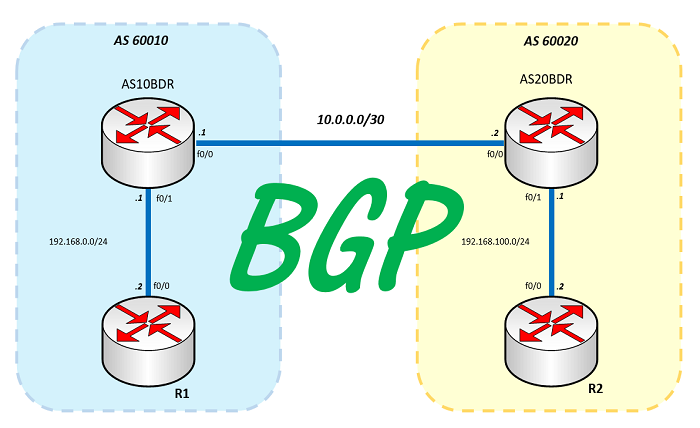Benefits of BGP Configuration

BGP (Border Gateway Protocol) is the network routing standard that routes traffic across autonomous systems or ASes. These are usually internet service providers or other large networks.
Routes are selected based on paths, rules, or network policies configured by an administrator. It means that BGP is a powerful tool for managing complex networks.
Enhanced Security
BGP is a network routing protocol that uses a centralized decision-making mechanism to determine the next hop for traffic. It is done through network prefix announcements, which every speaker sends to its neighboring autonomous systems (ASes).
The ASes then use the information to decide where traffic should go next. It can help avoid unnecessary packet losses on the internet, which can be a potential security problem.
However, this centralized routing can be vulnerable to attacks by malicious actors. These attackers can steal IP addresses from a network and reroute traffic intended for that network to a different destination, a process known as BGP hijacking.
One way to combat these attacks is to limit the number of networks advertising their IP address. It can be achieved through the classless interdomain routing (CIDR) principle.
Another essential feature of BGP is that it can aggregate routes, so they only need to be advertised once, reducing the amount of data sent over the internet. It can reduce memory requirements and improve overall performance.
In addition, BGP can be configured to support authentication. It can be done through a TCP-enhanced authentication option object inserted into BGP updates, a key, and a hash value.
Better Bandwidth Efficiency
BGP configuration enables businesses to improve bandwidth efficiency by optimizing how traffic is routed over the internet. Typically, this is done by setting policies that control how peers advertise routes in and out of the network. These policies can include community tags that regulate how peers advertise and accept specific courses.
In a standard BGP setup, a router’s routing table is constantly updated as new information arrives from peers. For example, if a link goes down and is replaced by a new link, the router must update its routing table to reflect these changes. If a router’s routing table is not adjusted quickly enough, it can cause the router to cycle between down and up states as it withdraws or announces routes.
As a result, BGP makes a best-path decision based on reachability, hop counts, and other path characteristics. It selects routes most likely to deliver a high throughput to a destination using these criteria.
To do this, BGP uses a finite state machine comprising six states: idle; connect; active; open sent; open confirm; and established. For each peer-to-peer session, the BGP implementation maintains a state variable that tracks which of these six states the session is in.
Scalability
Using BGP to connect multiple autonomous systems (AS) improves network security and bandwidth efficiency and reduces network complexity. In addition, BGP is more scalable than OSPF and is less prone to routing flapping.
Unlike OSPF, which focuses on finding the shortest path between nodes and failing over to that route as quickly as possible, BGP is a mesh protocol that enables sophisticated administrative routing policies. It is ideal for inter-AS networks and exceptional cases like informational feeds that need dynamic routing.
P2P sessions in BGP are managed using a finite state machine (FSM). Each session has six states: idle; connect; active; open sent; open confirm; and established.
The first state is idle, in which BGP initializes resources, refuses inbound BGP connection attempts, and initiates a TCP connection to the neighbor. Once the TCP connection is completed, the router transitions to connect state. If the TCP connection fails, a connect retry timer begins and transitions to an active state upon expiration.
Once the connect retry timer expires, the router tries to establish a TCP connection again. Eventually, it succeeds and transitions to the next state, OpenSent.
Then, it sends an Open message and waits for a response from the peer. If the reply is successful, it transitions to the OpenConfirm state. If unsuccessful, it resets the ConnectRetry timer and returns to the Idle state.
Easy to Implement
BGP is one of the most accessible routing protocols to implement. Its simplicity is a significant benefit, saving administrators time and effort.
An organization’s routing policy is based on many factors, including cost, reliability, speed, and other considerations. As each autonomous system collects and exchanges this information with other ASe, it translates the data into the best route for that particular destination.
For example, if an organization wants to ship a piece of mail internationally, it first sends it to the nearest post office branch. Then it uses a specific routing protocol to dispatch the packet to its final destination.
It is similar to what happens when an AS uses BGP to connect with other ASe. The data sent to the AS gets translated into the best BGP route for the destination and rerouted through the AS.
The next-hop paradigm dictates that a router only sends data to the most optimal or fastest path available. BGP’s ability to scan several options for a given destination allows it to choose the quickest route that minimizes network congestion.
BGP also supports conditional aggregation, which reduces the amount of routing information required to advertise routes and prefixes. The method involves combining the attributes of multiple prefixes into a single classless route, reducing the amount of data that needs to be promoted.





